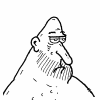Ronda, Spain is the Land of Bridges, Bandits and Bullfights
Published in Rick Steves' Europe
If you're like most Americans, your image of Spain is the region of Andalucia, famous for windswept landscapes, whitewashed hill towns, flamenco and gazpacho. While visitors gravitate to the region's big cities of Granada, Sevilla and Cordoba, Andalucia's hill towns -- a charm bracelet of cute villages perched in the sierras -- offer a taste of wonderfully untouched Spanish culture.
Ronda, 60 miles southeast of Sevilla, is one of the largest white hill towns. It's also one of the most spectacular, thanks to its gorge-straddling setting. Ronda is easy to visit because it's one of the few hill towns with a train station. The real joy for travelers lies in exploring the winding back streets and taking in the panoramic views, whitewashed houses, and exuberant flowerpots.
Ronda's stunning ravine divides the town's labyrinthine Moorish quarter and its newer, noisier, and sprawling Mercadillo quarter. The New Bridge, massive yet graceful, has mightily spanned the gorge since the 18th century. Look down (carefully) into the ravine -- it's 360 feet deep and 200 feet wide.
To Spaniards, Ronda is more famous for being the birthplace of modern bullfighting than for sporting a gorgeous gorge. In the 16th century, two kinds of bullfighting existed: the type with noble knights on horseback, and the coarser, man-versus-beast entertainment for the commoners (with no rules ... much like when WWF wrestlers bring out the folding chairs). In the 1700s, Francisco Romero melded these two forms, injected some rules, and created bullfighting as we know it today, complete with scarlet cape (though bulls are actually colorblind -- the red was to disguise the blood).
Ronda's bullring (and accompanying museum) is Spain's best -- superior even to Sevilla's. Built in 1785, 5,000 seats and 136 classy Tuscan columns surround the two-tiered arena to create a kind of 18th-century Italian theater feel. In Ronda, bullfighting is considered an art, not a sport -- newspapers cover fights in the culture section, not on the sports pages. Lovers of the "art" of bullfighting will explain that the event is about much more than the actual killing of the bull -- it's about celebrating the noble heritage and the Andalusian horse culture. The bulls -- and I -- disagree.
Ronda is not only about bullfighting. Drop by the Santa Maria church, built on the site of a former mosque and an earlier temple to Julius Caesar, for its interesting mix of Moorish, Gothic, Renaissance and Baroque fusion (or confusion). Ronda's unusual Lara Museum, which has everything from sewing machines and matador outfits to torture devices, hosts flamenco evenings three times weekly. For a look at Ronda's Moorish past, tour the ruins of the Arab Baths, which come to life with a video. The Bandolero museum features bandit lore and paraphernalia from the time Ronda was the romantic home of 19th-century banditos -- the Jesse Jameses and Billy el Ninos of Andalucia. To learn more about the history and prehistory of Ronda, tour the Mondragon Palace.
To really see prehistory, day-trip to the Pileta Cave, the best and most intimate look a tourist can get at prehistoric cave paintings in Spain. The farmer who owns the cave is a master at hurdling the language barrier. As you walk the cool half-mile, he'll spend an hour pointing out which paintings are five times as old as the Egyptian pyramids. The Neolithic and Paleolithic drawings of black, ochre, and red are mostly just lines or patterns, but there are also horses, goats, cattle, and a rare giant fish, made from a mixture of clay and fat by finger-painting prehistoric hombres.
Ronda is fun after dark. While day-trippers from the touristy Costa del Sol clog Ronda's streets during the day, locals retake the town in the early evening. I enjoy the fine tapas scene. Instead of picking one place, I do a tapa pub crawl, going from bar to bar sampling signature dishes such as lechuguita (a wedge of lettuce with vinegar, garlic, and a secret ingredient), huevo de codorniz (a tiny piece of oily toast with a slice of ham and a fried quail egg), and asparagus on a stick sprinkled with manchego cheese grated coconut-style. If a bar has a cardboard sign, "Hay caracoles" in its window, it's advertising it has snails, a special treat served from late spring through early fall. At tapas bars, you'll eat standing up, just like the locals.
The paseo (early evening stroll) happens in the new town, on Ronda's major pedestrian and shopping street, Carrera Espinel. Join in. Walking the streets, you feel a strong local pride in a community where everyone seems to know everyone.
========
Rick Steves (www.ricksteves.com) writes European travel guidebooks and hosts travel shows on public television and public radio. E-mail him at rick@ricksteves.com, or write to him c/o P.O. Box 2009, Edmonds, Wash. 98020.
(c)2008 RICK STEVES DISTRIBUTED BY TRIBUNE MEDIA SERVICES, INC.














Comments